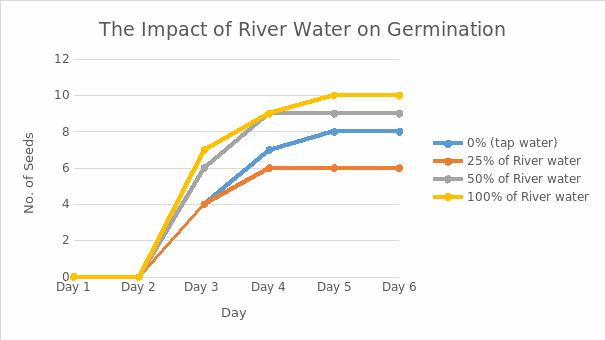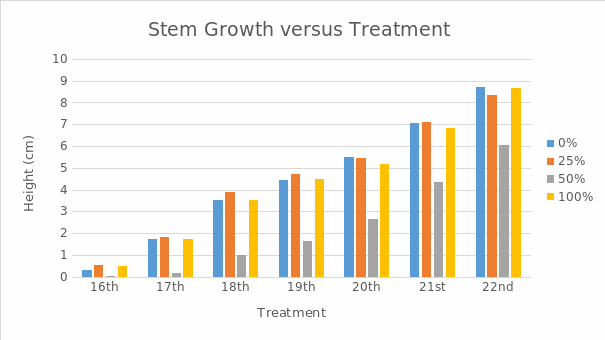Abstract
Normal plant growth occurs in the presence of water, adequate nutrients, and light. The goal of this study was to investigate the impact of the James River water at varying concentrations on the growth of wheat plants. The highest growth rates were realized in the plants treated with 0%, 25%, and 100% of river water. The lowest growth rate was observed in the 50% treatment. However, the differences were not statistically significant implying that the river water contained certain substances that promoted the healthy growth of plants.
Introduction
The growth and development of plants require three major factors: water, light, and nutrients (Lin et al. 86). Water plays a vital role in all stages of plant growth. For example, during germination, water is taken up through the process of imbibition to break the seed coat and activate the enzymes that catalyze the biological reactions need for germination. Water is a raw material for photosynthesis, which produces food for the plant. The uptake of water causes plant cells to swell up thus providing support to the plant. Water also dissolves minerals and nutrients and transports them to various parts of the plant hence making them available for plant use.
Any alterations in the composition of these basic factors affect plant growth and development. Various studies have looked into the effect of different salt types and concentrations on the germination and growth of plants. It has been shown that increasing salt concentrations reduce the rate of germination. River water contains living organisms such as algae, bacteria and aquatic animals in addition to chemical pollutants. Therefore, these components are expected to affect plant growth.
River James is the largest river in the state of Virginia. It occupies an area of about 10,000 square miles (Wood et al. 5194). Its length is approximately 580 kilometers. It ranks twelfth among the longest rivers that occupy a single state. The river contains many parks and leisure attractions. Some of the activities that are carried out in the river include fishing, canoeing, kayaking, rock climbing, skiing, and swimming. The James River has eight dams that are used for the generation of mechanical power. The diverse activities on the James River expose it to different pollutants, which affect its water quality. Efforts are being made to monitor the quality of the water. The latest findings show that the river has a general score of 61% (James River Association, 2016). The prevalence of pathogenic bacteria in the river’s tributaries further put the quality of the water to scrutiny.
Research Objective
This experiment aimed at finding the effect of different concentrations of water from River James water on the germination and growth of wheat seeds.
Hypothesis
It was postulated that adding river water to the seeds would have a negative effect on the germination and development of wheat seeds. Therefore, the primary null hypothesis was that there were no significant differences in the average measurements among groups.
Methods
- 40 wheat seeds were planted in four Ziploc bags (each containing 10 seeds) moistened with river water at concentrations of 0% (negative control), 25%, 50% and 100% and allowed to germinate. The germination rate was observed and recorded. Seven seedlings from each treatment group were transferred to vases with soil, which were labeled accordingly.
- The different concentrations of water from the James River were added to the corresponding plants at the start of the second week only. After that, a tablespoon of pure water was added to each of the pots on a daily basis to ensure that the soil remained wet.
- The growth of the seedlings was monitored for growth characteristics such as the length of stems, the absorption of water, and root features, which were recorded every day during the second week.
- Kruskal-Wallis test was used find the statistical significance of the differences among treatment groups.
Results
Table 1: Seed germination for each treatment.


The rate of germination increased with an increase in river water concentration and was highest in 100% river water where total germination was observed by day 5 as shown in Table 1 and Figure 1. The rate of plant growth as per the stem length was observed in the controls (0%) followed by 25% and 100% treatment solutions as shown in Figure 2. The plants treated with 50% river water had the lowest growth rate. The emergence of roots from the soil was seen in plants containing 0, 25 and 100% solutions. The statistical results for the plant growth produced a chi-square value of 2.313 at 3 degrees of freedom and a p-value of 0.51. The seed germination had a chi-square of 3 at 3 degrees of freedom and a p-value of 0.39. In both instances, the p-values were greater than α (0.05) thus implying that the differences were not statistically significant.
Discussion
Healthy plant growth was observed in the 0%, 25%, and 100% solutions. These observations refuted the alternate hypothesis suggesting that the James River water had no effect on the germination and growth of wheat plants. These observations could be accounted for by the presence of macro and micronutrients in river water. A study by Ahemad and Kibret (5) reports that river water contains rhizobacteria that promote the uptake of water and nourishment by plants, which leads to high growth rate. This observation explains the high germination and growth rates seen in plants treated with 100 river water.
The lowest growth rate was realized in 50% river water. There was no plausible explanation for this phenomenon given that high growth rates were observed at the low and high concentrations of the river water. The growth of plants is dependent on additional factors such as the availability of light, temperature, and water quantities. However, these factors were kept constant as all plants were grown under similar conditions. One possible reason for this observation is the nutritional composition of the soil. There was a likelihood that the soil in these pots lacked a given nutrient. Nevertheless, this supposition cannot be confirmed unless the nutritional status of the soil is ascertained.
Future studies can determine the precise chemical composition of the James River water in terms of microbial populations, levels of macro and micronutrients as well as harmful compounds such as lead. Such an analysis can enable the accurate prediction of the impact of the water on plant germination and growth.
Works Cited
Ahemad, Munees, and Mulugeta Kibret. “Mechanisms and Applications of Plant Growth Promoting Rhizobacteria: Current Perspective.” Journal of King Saud University-Science 26.1(2014): 1-20. Print.
James River Association. (2016b). State of the James. Web.
Lin, Kuan-Hung, Meng-Yuan Huang, Wen-Dar Huang, Ming-Huang Hsu, Zhi-Wei Yang, and Chi-Ming Yang. “The Effects of Red, Blue, and White Light-Emitting Diodes on the Growth, Development, and Edible Quality of Hydroponically Grown Lettuce (Lactuca sativa L. var. capitata).” Scientia Horticulturae 150(2013): 86-91. Print.
Wood, Joseph D., Rima B. Franklin, Greg Garman, Stephen McIninch, Aaron J. Porter, and Paul A. Bukaveckas. “Exposure to the Cyanotoxin Microcystin Arising from Interspecific Differences in Feeding Habits among Fish and Shellfish in the James River Estuary, Virginia.” Environmental Science & Technology 48.9(2014): 5194-5202. Print.
